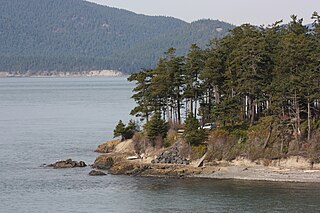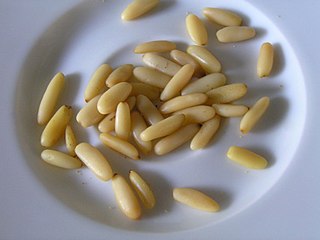
A pine is any conifer tree or shrub in the genus Pinus of the family Pinaceae. Pinus is the sole genus in the subfamily Pinoideae.

The Douglas fir is an evergreen conifer species in the pine family, Pinaceae. It is native to western North America and is also known as Douglas-fir, Douglas spruce, Oregon pine, and Columbian pine. There are three varieties: coast Douglas-fir, Rocky Mountain Douglas-fir and Mexican Douglas-fir.

Pine nuts, also called piñón, pinoli, or pignoli, are the edible seeds of pines. According to the Food and Agriculture Organization, only 29 species provide edible nuts, while 20 are traded locally or internationally owing to their seed size being large enough to be worth harvesting; in other pines, the seeds are also edible but are too small to be of notable value as human food. The biggest producers of pine nuts are China, Russia, North Korea, Pakistan and Afghanistan.

Pinus radiata, the Monterey pine, insignis pine or radiata pine, is a species of pine native to the Central Coast of California and Mexico. It is an evergreen conifer in the family Pinaceae.

Pinus nigra, the Austrian pine or black pine, is a moderately variable species of pine, occurring across Southern Europe from the Iberian Peninsula to the eastern Mediterranean, on the Anatolian peninsula of Turkey, Corsica and Cyprus, as well as Crimea and in the high mountains of Northwest Africa. Black pine, located in the Banaz district of Uşak, Türkiye, is estimated to be 1000 years old and is the oldest larch in the world. It has a length of 11 meters, a diameter of 3 meters and a circumference of 9.60 meters.

Pinus strobus, commonly called the eastern white pine, northern white pine, white pine, Weymouth pine (British), and soft pine is a large pine native to eastern North America. It occurs from Newfoundland, Canada, west through the Great Lakes region to southeastern Manitoba and Minnesota, United States, and south along the Appalachian Mountains and upper Piedmont to northernmost Georgia and perhaps very rarely in some of the higher elevations in northeastern Alabama. It is considered rare in Indiana.

Pinus ponderosa, commonly known as the ponderosa pine, bull pine, blackjack pine, western yellow-pine, or filipinus pine, is a very large pine tree species of variable habitat native to mountainous regions of western North America. It is the most widely distributed pine species in North America.

The Xyelidae are a comparatively species-poor family of sawflies, comprising about 80 extant species in five genera worldwide, and is the only family in the superfamily Xyeloidea. The fossil record of the family is extensive, comprising more than 120 species and including the oldest fossil Hymenoptera species dating back to the Triassic, between 245 and 208 million years ago. Xyelidae are to be regarded as living fossils since they represent one of the oldest lineages of insects and include still extant forms.

Xyela is a genus of sawflies, belonging to the family Xyelidae.
Xyela alpigena is a species of sawfly in the genus Xyela and is endemic to North America. It can be found from Quebec to Maryland and Maine, and west to Utah and New Mexico. The host plant for the larvae is Pinus strobus.
Xyela bakeri is a species of sawfly in the genus Xyela and is endemic to North America. It can be found from Quebec to Florida, and west to British Columbia and California. It has widespread hosts for its larvae, including Pinus elliottii, P. palustris, P. ponderosa, P. sabiniana, and P. virginiana.
Xyela californica is a species of sawfly in the genus Xyela that is endemic to California.
Xyela cheloma is a species of sawfly in the genus Xyela that is endemic to North America. It can be found in Idaho, Nevada, British Columbia, Washington, and Oregon. The host for the larvae is Pinus ponderosa.
Xyela concava is a species of sawfly in the genus Xyela that is endemic to North America. It can be found in Utah, Nevada, and California. The host for the larvae is Pinus monophylla and P. ponderosa.
Xyela deserti is a species of sawfly in the genus Xyela that is endemic to North America. It can be found in Nevada and California. The host for the larvae is Pinus monophylla.
Xyela dodgei is a species of sawfly in the genus Xyela that is endemic to Florida.
Xyela gallicaulis is a species of sawfly in the genus Xyela that is endemic to North America. It can be found in Virginia and Georgia. The larva feeds inside shoots and forms galls in its host which include: Pinus echinata, P. elliottii, and P. taeda.
Xyela linsleyi is a species of sawfly in the genus Xyela that is endemic to North America. It can be found in Idaho, British Columbia, Washington, and California. The host for the larvae is Pinus ponderosa.
Xyela minor is a species of sawfly in the genus Xyela that is endemic to North America. It can be found from Quebec to Florida, and west to British Columbia and California. The larvae have widespread hosts, including: Pinus coulteri, P. elliottii, P. muricata, P. palustris, P. ponderosa, P. sabiniana, P. taeda, and P. virginiana.








